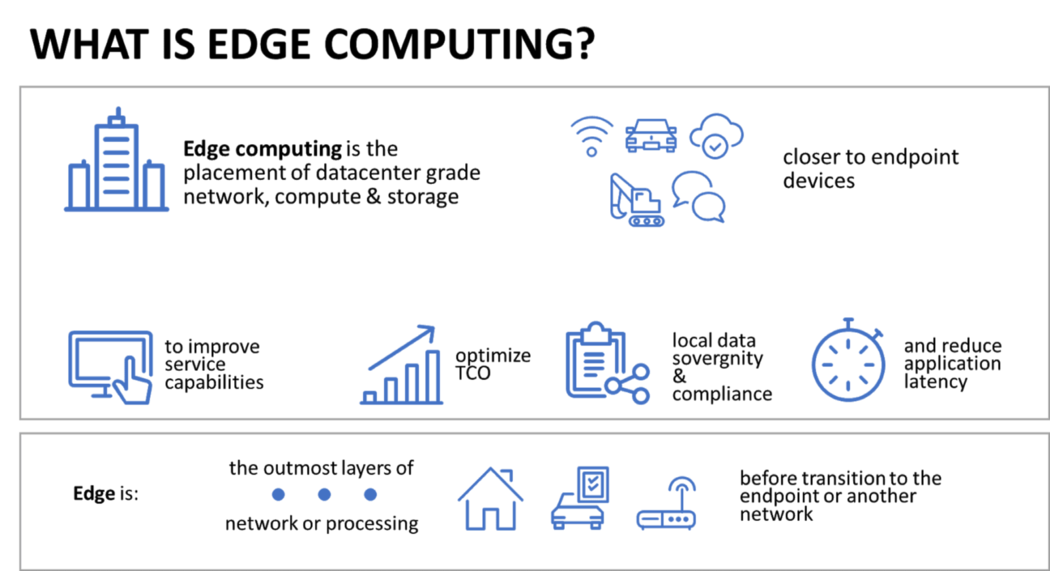Apr25

The IDC forecasts the global edge computing market to reach $250 billion by 2024, with a compounded annual growth of 12.5%. No wonder the industry is talking about Edge Computing.
Edge computing is one of the “new revolutionary technologies” that can change organizations wanting to break free from previous limitations of traditional cloud-based networks. The next 12–18 months will prove to be the natural inflection for edge computing. Practical applications are finally emerging where this architecture can bring real benefits.
91% of our data today is created and processed in centralized data centers. Cloud computing will continue to contribute to businesses regarding cost optimization, agility, resiliency, and innovation catalyst. But in the future, the “Internet of Behaviors (IoB)” will power the next level of growth with endless new possibilities to re-imagine the products & services, user experiences, and operational excellence. The IoB is one of the most sought-after and spoken-about strategic technology trends of 2021. As per Gartner, the IoB has ethical and societal implications, depending on the goals and outcomes of individual uses. It is also concerned with utilizing data to change behaviors. For instance, with increased technologies that quickly gather dust, information can influence behaviors from feedback loops during times such as COVID-19 monitoring.
IoT, IIoT, AI, ML, Digital Twin, and Edge computing are at the core of the Internet of Behaviors. As per Gartner’s research, about 75% of all data will require analysis and action at the Edge by 2022. Organizations have been debating what separates edge computing from the other traditional data processing solutions. Also, whether it is excellent for their business and to what extent is a hot topic.
The foundational principles of edge computing are relatively simple to comprehend but understanding its benefits can be complex. Edge computing can provide a direct on-ramp to a business’ cloud platform of choice and assists in achieving flexibility to facilitate a seamless IT infrastructure.
It is a distributed computing model where computing is conducted close to the geographical location of the data collection and analysis center, overusing a centralized server or Cloud. The improved infrastructure uses sensors to gather data, while the edge servers safely process data on-site in real-time.
By miniaturizing the processing and storage tech, the network architecture landscape has experienced a massive shift in the right direction, where businesses can worry less about data security. The present-day IoT devices can quickly gather, store, and process vast amounts of data than they could before. This creates more opportunities for businesses to integrate and update their networks to relocate their processing functions in proximity to the data gathered at the network edge to be assessed and applied in real-time closer to the intended users.
Edge computing is essential now because it is an upgrade for global businesses to improve their operational efficiency, boost their performance, and ensure data safety. It will also facilitate the automation of all core business processes and bring about the “always-on” feature. Edge computing holds the key to achieving total digital transformation of conducting business more efficiently.
Edge technology is relevant today as it’s empowered by new technologies such as 5G, Digital Twin, and Cloud-native Application, Database, and Integration platforms.
By 2025, we will witness 1.2 billion 5G connections covering 34% of the global population. Highly reliable low-latency is the new currency of the networking universe, underpinning new capabilities in many previously impossible industries. With 5G, we’ll see a whole new range of applications enabled by the low-latency of 5G and the proliferation of edge computing, transforming the art of the possible.
Moreover, Private 5G Network will fuel Edge computing and push enterprises to the Edge. Forrester sees immediate value in private 5G — a network dedicated to a specific business or locale like a warehouse, shipyard, or factor.
Response time or speed of response is an absolute necessity for the AI/ML-powered solution, especially if deployed in a remote location or the user is on the move. If there is even a millisecond of delay in the algorithms of a remote patient monitoring system at hospitals, it could cost someone their life. Companies that render data-driven services cannot afford to lag in speed as it can have severe consequences to the brand reputation and customer’s quality of experience.
Container technology like Docker and Kubernetes allows companies to run prepackaged software containers more quickly, reliably, and efficiently. Armed with these technologies, companies can set up and scale Micro Clouds wherever and however they want.
Service and Data mesh facilitate a channel to release and query data or services distributed through datastores and containers across the Edge, making it a critical enabler. It also allows bulk queries for the entire population within the Edge over each device, bringing greater ease.
Software-defined networking enables the configuration of the overlay networks by users, making it simpler to customize routing and bandwidth to determine a way to connect edge devices and the Cloud.
The digital twin is a crucial enabler responsible for organizing physical-to-digital and cloud-to-edge, letting domain experts (not just software engineers) configure their applications to observe, think and act according to the Edge.
The maturity of IIoT platforms and Edge AI pave the way for IT-OT convergence, thereby offering an innovation advantage to the business.
The industrial Internet of Things or IIoT sensors provides a more significant business advantage such as greater productivity and efficiency and cost reduction for data collection, analysis, and exchange.
MES transforms the topology and the architecture of mobile networks from a pure communication network for voice and data to an application platform for services. MEC complements and enables the service environment that will characterize 5G. Example: Connected Cars, Industry 4.0, Remote Patient Monitoring, eHealth.
XR represents an immersive interface for work collaboration in a virtualized environment. With the help of edge computing, these experiences become even more detailed and interactive.
Innovation for Heterogeneous hardware and ruggedized HCI / Edge devices is making Edge computing more pervasive as they process a greater volume of data quickly by using lesser power. Integrating this specialized hardware on Edge enables efficient computation within physical environments while accelerating the response rates.
Hyperscalers, along with 5G and chip OEM, are innovating at speed to capture the market. Azure Percept is Microsoft’s latest edge computing platform, bringing the best hardware, software, and cloud services to the Edge. Azure Percept is an excellent device for makers and builders to build and prototype intelligent IoT applications powered by Azure Cognitive Services and Azure Machine Learning Services.
New privacy-oriented technologies include techniques and hardware that enable data to be processed without exposing all the problematic aspects. Data is encrypted during storage and transmission. However, privacy-preserving tech is bound to safeguard data even in the computing stage, making it more reliable for other lines of the organization and its partners, especially when required to be processed on Edge.
Robotics can be configured to act following signals and updates by the Edge. This has been seen in life-saving surgical procedures where agility and precision are of utmost importance. Both Edge and Cloud are of utmost importance to control the robot’s moves and executions through stored data while ensuring no lag between movements.
From what we are witnessing so far, Edge Computing represents the future of a cloud technology extension by making it bulletproof. Discussed below are a few ways we may see this continuum manifest:
A substantial amount of computing is already being carried out on Edge at manufacturing units, hospitals, and retail sectors, where the majority operate on the most sensitive data. It also powers the most critical systems that are required to function safely and reliably. Edge can facilitate the driving of decisions on these core functional systems. When there is the opportunity for AI and IoT to tap into these systems.
Understanding and assuming control of the Edge also gives you control of the closest point of data action. Utilizing this unique opportunity to relay differentiated services can help a business in great ventures with valuable partnerships that branch out.
For instance, edge computing is beneficial to an automobile manufacturer and the insurance vendor, the companies that provide energy and utilities, and the city planners. Edge computing can offer your business new data, and you can offer more excellent value to your partners, which is a win-win scenario. The new edge-friendly data and services are processed in the Cloud, integrating with other organizational applications and data.
Edge computing is the need of the hour to maximize the returns of the next-generation technologies, as the current scope needs to be broadened anyway. As time passes, so does the need for a better technological support system for data processing that is faster, smarter, and more efficient. Their collective effect can give new features such as voice input to your vehicle or remorse operations using teleoperation. Edge facilitates the control and programmability required to link these capabilities into an organization.
Today’s Cloud world is characterized by limited mega data centers in remote locations. Data is traversing from one device to the Cloud and back to execute a computation or data analysis. Data typically make this round trip traveling at 50 to 100 milliseconds over today’s 4G networks.
Data traveling over 5G at less than five milliseconds facilitates the edge cloud and the ability to create new services that it empowers.
Decentralizing traditional IT infrastructure is at the core of edge computing and complementary to centralized cloud computing.
One of the three origins of distributed Cloud is edge computing, making it highly relevant for prospects. CIOs can use distributed cloud models to target location-dependent cloud use cases required in the future. As per Gartner, by 2024, most cloud service platforms will facilitate at least a few distributed cloud services that execute at the point of need. Distributed Cloud retains the benefits of cloud computing. However, it extends the range and uses cases for the Cloud, making it a better version.
Today, everything is getting “smart” / “intelligent” because of technology. From home appliances and automobiles to industrial equipment, substantial products and services are employing the aid of AI to interpret commands, analyze data, recognize patterns, and make decisions for us. Most of the processing that powers today’s intelligent products is handled remotely (in the Cloud or a data center), where there’s enough computing power to run the required algorithms.
Edge, combined with 5G’s higher bandwidth and Distributed Cloud’s low-latency computation, is the future that was imagined less than a decade ago and is within our reach, now more than ever. What is impressive about this technology is how several technological leaps and bounds are more significant than we could imagine. To think about it, edge computing is just like science fiction materializing, only that the experience is full of greater possibilities and expansion. Not only will your business be facing a new generation of success, using the Edge will help you run your organization more efficiently, create more incredible innovations at a fast-paced process faster and derive better value from affiliations.
Keywords: Cloud, COVID19, Digital Twins
 The Board Chair as the Primary Lever of Psychological Safety
The Board Chair as the Primary Lever of Psychological Safety Friday’s Change Reflection Quote - Leadership of Change - Change Leaders Maintain Trust and Legitimacy
Friday’s Change Reflection Quote - Leadership of Change - Change Leaders Maintain Trust and Legitimacy The Corix Partners Friday Reading List - January 16, 2026
The Corix Partners Friday Reading List - January 16, 2026 Effective Government Is Built: A Five-Pillar Framework for Public Leaders
Effective Government Is Built: A Five-Pillar Framework for Public Leaders Tariffs, Data, and the Complexity of Compliance
Tariffs, Data, and the Complexity of Compliance